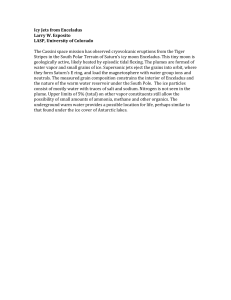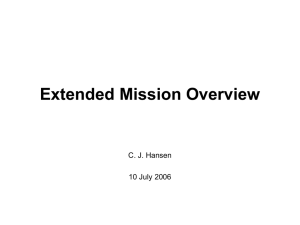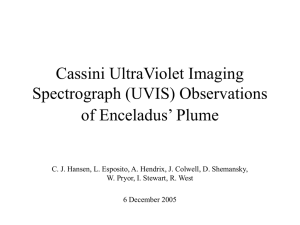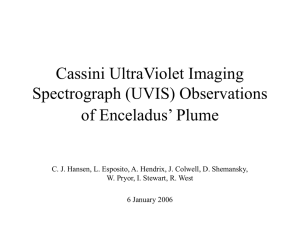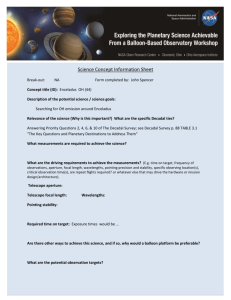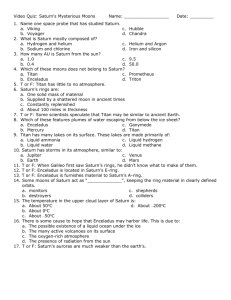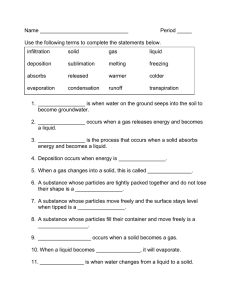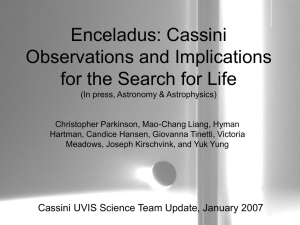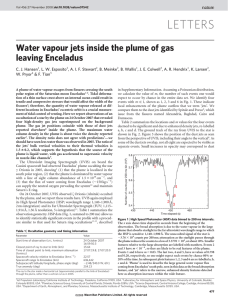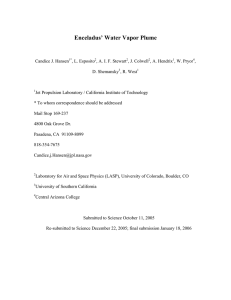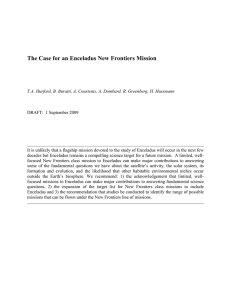Enceladus Plume Simulations Feng Tian Ian Stewart Brian Toon
advertisement
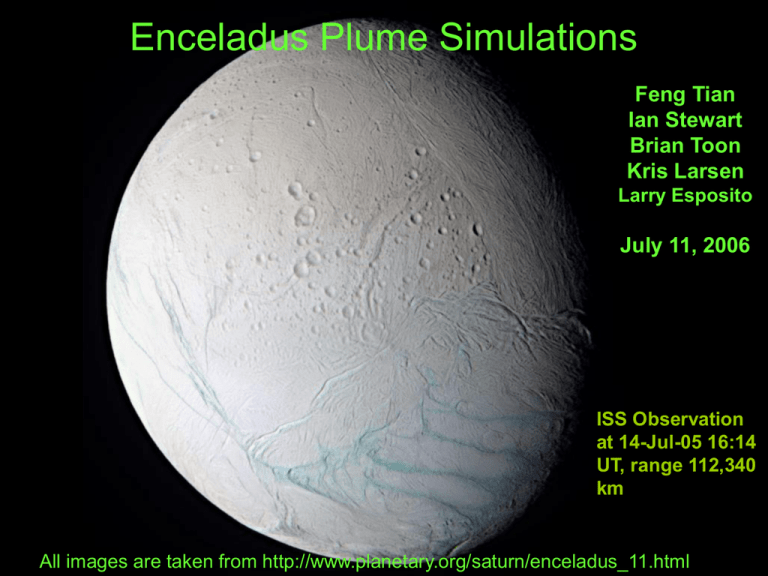
Enceladus Plume Simulations Feng Tian Ian Stewart Brian Toon Kris Larsen Larry Esposito July 11, 2006 ISS Observation at 14-Jul-05 16:14 UT, range 112,340 km All images are taken from http://www.planetary.org/saturn/enceladus_11.html Observations Related to the Plume • Magnetometer: B field lines of Saturn bending around an extended atmosphere at Enceladus + a "comet-like jet“ • CIRS: hot spot at temperatures >90K -- even more than 140 K • INMS: water maximum at ~37 s before its closest approach (CA) -- nearly coincident with CA to the CIRS hot spot. • CDA: dust maximum at ~70 s before CA • ISS: direct observation of icy particles in plumes • UVIS Stellar Occultation Observations Importance of the Plume on Enceladus • • - source of icy particles in Saturn's Ering • - source for atomic oxygen around Saturn • - source for observed OH cloud around Saturn • - THE missing source of water at the orbit of Enceladus? Questions to address : • Constraints on water escape rate through more detailed modeling • Estimate deposition rate • Physical characteristics of the plume – is the UVIS data consistent with evaporation from a large icy area near the south pole? – if not, it it consistent with water escaping at some bulk velocity through a vent or system of vents in the surface? Constant-number Time-driven Monte Carlo Simulation -- Marching through time in steps chosen so that no more than one collision in dt -- Assumption on density distribution to compute collision frequency -- Checks status of activities in each time step: 1. compute free path and the destination 2. If collision occurs, reset velocity at the collision site and recalculate the destination 3. Check for multi-collision event 4. Return particles reaching 4 Re to origin -- More efficient than Event-Driven algorithm in the case of Enceladus -- Can be visualized as process in time example Geometry of the South Polar Region on Enceladus Tian et al. Submitted to Icarus Column Density Distribution for a Single Source Average distance between adjacent sources along the Tiger Stripes is ~20 km. Plumes merge together at high altitudes exact locations for the point sources not important. Both vertical (altitude) and horizontal displacements need to be considered Occultation Geometry by Ian Stewart Monte Carlo Model - Fit to Data Best fit to UVIS column density as a function of altitude requires a vertical velocity of 300 to 500 m/sec vent instead of sublimation Water escape rate is 4~6 x 1027 molecules/sec, = 120~180 kg/sec, consistent with lower rate from previous estimate (Hansen et al. 2006). 1000 times greater than the particles escape rate inferred from the ISS observations (Porco et al. 2006) Other Water Source Rates • Amount required to supply OH: – ~4x1027 s-1 = 120 kg/s (Jurac et al. 2002) • Cassini Plasma Spectrometer (CPS): >=3x1027 s-1 = 100 kg/s mass loading rate (Tokar et al. 2006) • INMS: 1.5~4.5x1026 s-1 <15 kg/s (Waite et al. 2006) – highly variable source rate (1x1026 s-1 to 3x1027 s-1) in time scales of less than 1 hour • ISS: ~0.04 kg/s (Porco et al. 2006) – Sensitive to large particles >0.1 m – 1% ejected particles escaping • Cosmic Dust Analyzer: ~0.02 kg/s (Porco et al. 2006) Particles > 2 m Water Deposition Rate • Globally averaged: (2-7)x109 cm-2s-1 – Comparable to sputtering rate estimated (Shi et al. 1995, Jurac et al. 2001) • Deposition rate in the South Polar Region (latitude > 75o): (0.5-2)x1011 cm-2s-1 – Net growth than net erosion? • High resurfacing rate in the south polar region: (0.5-2)x10-4 cm/yr – High albedo Summary • 1. Water source rate high enough to supply water in the Saturn system. • 2. Deposition rate higher than sputtering rate in the polar region. • 3. High surface velocity suggests vent rather than sublimation. Questions? ?
